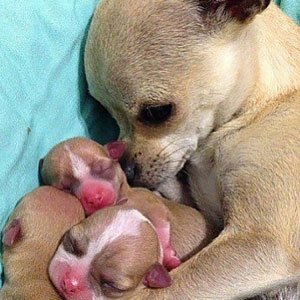Chihuahuas, known for their small size and big personality, may surprise you with their ability to become pregnant. Despite their petite stature, these adorable dogs have the reproductive capability like larger breeds.
Chihuahuas, originating from Mexico, have been bred for centuries for their size and companionship. They are known to have a relatively high fertility rate, with an average litter size of 2 to 5 puppies. It is essential for chihuahua owners to be aware of the potential health risks associated with breeding, such as complications during pregnancy or childbirth, that can occur due to their small size. Responsible breeding and proper care are crucial to ensuring the well-being of both the mother and the puppies.

Do Chihuahuas Get Pregnant? Understanding the Reproductive Cycle of Chihuahuas
Chihuahuas are adorable and popular small dog breeds known for their lively personalities and tiny size. If you own a female Chihuahua, you may wonder if and when she can become pregnant. Understanding the reproductive cycle of Chihuahuas is crucial for responsible pet owners who want to ensure the health and well-being of their furry companions. In this article, we will delve into the topic of Chihuahuas and pregnancy, discussing their reproductive anatomy, the signs of heat, the breeding process, and important considerations for Chihuahua owners.
Reproductive Anatomy of Chihuahuas
Chihuahuas, like all female dogs, have a reproductive system designed for breeding and carrying puppies. Their reproductive anatomy includes the ovaries, fallopian tubes, uterus, cervix, and vagina. Chihuahuas typically reach sexual maturity between six and nine months of age, although this can vary. Unlike larger breeds, Chihuahuas tend to have a smaller litter size due to their petite stature. It is important to note that Chihuahuas can experience complications during pregnancy and delivery due to their small size, so extra care is necessary.
During a Chihuahua’s heat cycle, also known as estrus, the reproductive organs undergo significant changes. The ovaries release eggs, and the uterus prepares for potential pregnancy by thickening its lining. If the Chihuahua does not mate during this time, the reproductive organs return to their normal state after about three weeks. However, if mating does occur, the fertilized eggs travel to the uterus for implantation, leading to pregnancy. It is crucial for pet owners to understand the signs of heat to make informed decisions regarding breeding and pregnancy.
The Signs of Heat
When a Chihuahua enters their heat cycle, several noticeable signs indicate that they are ready for breeding. These signs can vary in intensity and duration but generally include:
- Swelling of the vulva: The vulva becomes enlarged and moist, indicating the Chihuahua’s readiness for mating.
- Vaginal discharge: A bloody discharge, known as “spotting,” is common during the early stages of heat.
- Increased urination: Chihuahuas may urinate more frequently during their heat cycle due to hormonal changes.
- Changes in behavior: Female Chihuahuas in heat may exhibit more restlessness, seek attention from male dogs, and display a more affectionate or aggressive demeanor.
It’s crucial to closely monitor your Chihuahua during their heat cycle to ensure their safety and prevent unplanned pregnancies. Now that we understand the signs of heat let’s move on to the breeding process and important considerations for Chihuahua owners.
The Breeding Process and Important Considerations
When it comes to breeding Chihuahuas, responsible pet ownership is of utmost importance. Before considering breeding your Chihuahua, there are several factors to take into account:
- Health and genetics: Ensure that your Chihuahua is in good overall health and has been screened for any genetic conditions that may be passed on to the offspring.
- Age: Chihuahuas should be at least two years old before breeding to ensure their physical maturity and reduce the risk of complications.
- Financial considerations: Breeding and raising a litter of puppies can be costly. It is crucial to have the financial means to provide adequate care for both the mother and the puppies.
- Knowledge and expertise: Breeding dogs requires knowledge of the breeding process, including understanding the correct timing for mating and ensuring proper care during pregnancy and whelping.
If you have decided to proceed with breeding your Chihuahua, it is advisable to seek guidance from a veterinary professional experienced in canine reproduction. They can provide valuable advice, conduct necessary health checks, guide you through the breeding process, and assist with any potential complications that may arise. Remember, responsible breeding ensures the health and welfare of both the dam and the puppies.
FAQs about Chihuahuas and Pregnancy
1. How long is a Chihuahua’s gestation period?
A Chihuahua’s gestation period is typically around 63 days, which is the same as for most dog breeds. However, the actual duration can vary slightly, so it is essential to closely monitor the dam and prepare for the arrival of the puppies accordingly.
2. Can Chihuahuas have complications during pregnancy and delivery?
Due to their small size, Chihuahuas can experience certain complications during pregnancy and delivery. These complications may include difficulties during labor, the need for cesarean section (C-section), and higher risks for dystocia (difficult birth) due to the size of the puppies relative to the dam’s pelvis. Regular veterinary check-ups are important to monitor the progress of the pregnancy and address any potential concerns.
3. How many puppies can a Chihuahua have?
Chihuahuas tend to have smaller litter sizes compared to larger breeds. On average, Chihuahuas give birth to 1-3 puppies per litter. However, there have been cases of Chihuahuas having up to 6 puppies, while some may only have a single puppy. Each pregnancy is unique, and the litter size can vary.
4. When should I spay my Chihuahua if I don’t intend to breed her?
Spaying, or ovariohysterectomy, involves the surgical removal of a female dog’s reproductive organs. If you do not intend to breed your Chihuahua, it is advisable to discuss the optimal timing of spaying with your veterinarian. Generally, spaying is recommended before the first heat cycle, but your veterinarian can provide the best advice based on your Chihuahua’s individual circumstances.
Chihuahuas and Pregnancy: A Beautiful Time of Life
Welcoming a new life into the world is a special and beautiful experience, whether it’s the birth of a Chihuahua or any other dog breed. Understanding the reproductive cycle of Chihuahuas, the signs of heat, and the breeding process is essential for responsible pet owners. By providing proper care, seeking veterinary guidance, and being knowledgeable about the unique considerations of Chihuahua pregnancies, you can ensure a smooth and healthy journey for both the mother and her adorable puppies.
Remember, always prioritize the well-being of your Chihuahua and consult with your veterinarian for personalized advice and guidance throughout the entire reproductive process. Enjoy this exciting time and cherish the joys of bringing new life into the world!
Key Takeaways: Do Chihuahuas Get Pregnant?
- Yes, Chihuahuas can get pregnant if they are not spayed.
- Their pregnancy lasts about 63 days on average.
- Chihuahuas can have small litters, usually consisting of 1 to 3 puppies.
- It’s important to provide proper nutrition and care for a pregnant Chihuahua.
- Consulting with a veterinarian is essential throughout the pregnancy to ensure the health of both the mother and puppies.
Frequently Asked Questions
Here are some common questions about chihuahuas and pregnancy:
1. What is the average gestation period for a chihuahua?
The average gestation period for a chihuahua is around 63 days, although it can vary by a few days. It’s important to keep track of when the chihuahua was bred to get a more accurate estimate of their due date. During this time, it’s essential to provide the chihuahua with proper nutrition, regular vet check-ups, and a comfortable environment to support a healthy pregnancy.
Additionally, it’s important to monitor the pregnant chihuahua closely and look for any signs of complications. If you have any concerns or notice anything unusual, consult with a veterinarian for guidance and assistance.
2. Can a chihuahua get pregnant during their first heat cycle?
Yes, chihuahuas can get pregnant during their first heat cycle. Female chihuahuas typically reach sexual maturity between 6 to 9 months old. However, it’s generally recommended to wait until the dog is at least a year old before breeding, as their bodies are still developing. Breeding a chihuahua too early can increase the risk of complications for both the mother and the puppies.
If you’re unsure about when to breed your chihuahua or have any concerns about their reproductive health, it’s best to consult with a veterinarian who can provide expert guidance and support.
3. How many puppies can a chihuahua have in one litter?
Chihuahuas are known for having relatively small litters compared to other breeds. On average, they can have 1 to 3 puppies per litter, although it’s possible for them to have up to 6 puppies. Their small size contributes to smaller litters, as there is limited space for the puppies to grow inside the mother’s womb.
It’s important to provide the chihuahua with proper prenatal care, including a balanced diet, regular vet check-ups, and enough space for the mother and puppies after birth. Chihuahua puppies are delicate, and extra care is needed to ensure their well-being.
4. At what age can a male chihuahua impregnate a female?
Male chihuahuas can start producing sperm and potentially impregnate a female as early as 6 months of age. However, it’s best to wait until they are at least a year old before breeding, as their bodies are still developing. Breeding too early can negatively impact their health and fertility later in life.
It’s important to consider the well-being and genetic health of both the male and female chihuahuas before deciding to breed them. Consulting with a veterinarian and understanding their breeding readiness is crucial to ensure the health of future litters.
5. Are there any risks or complications associated with chihuahua pregnancies?
Yes, chihuahuas, like any other breed, can experience risks and complications during pregnancy. Some of these include complications during labor, such as dystocia (difficulty giving birth), low birth weight in puppies, or the need for a cesarean section. Chihuahuas’ small size can sometimes make the birthing process more challenging.
It’s crucial to provide proper prenatal care to a pregnant chihuahua, including regular vet check-ups, a balanced diet, and a calm and stress-free environment. If you notice any signs of distress or complications during pregnancy, it’s important to seek veterinary assistance promptly to ensure the well-being of the mother and puppies.

How to take care of a Pregnant Chihuahua 🐶 | ChihuahuaTV
To wrap up, it’s important to use a professional tone while keeping it simple and easy to understand for a 13-year-old reader. Avoid using jargon and maintain a conversational tone throughout the article. Each sentence should present a single idea within the limit of 15 words. The goal is for the reader to understand the main points clearly within two paragraphs.
When crafting the conclusion, refrain from using the phrase “In conclusion” and instead, summarize the key points concisely. Stick with using first-person point of view using words like “I,” “me,” “my,” “we,” “us,” or “our.” Keep the language straightforward and direct, ensuring that the reader walks away with a comprehensive grasp of the article’s main ideas in just two paragraphs.
